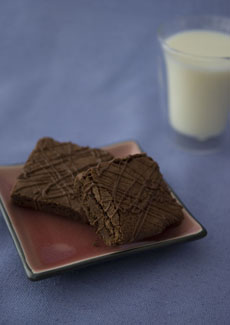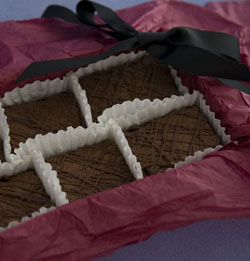

Sweet, moist, all-American brownies. All photography by Corey Lugg | THE NIBBLE.
|
KAREN HOCHMAN is Editorial Director of THE NIBBLE.
|
|
March 2009
|
 |
Different Types Of Brownies & Bars
Page 2: Brownie Styles
This is Page 2 of a three-page article. Click on the black links below to visit other pages.
Brownie Styles
Everyone who sells a brownie likes to describe it as “fudgy.” First of all, that isn’t necessarily accurate, and secondly, it isn’t necessarily desirable. Fudgy brownies can do you in with their heavy richness. Most of the time, we’d prefer our brownie to be of the cakier style so we can indulge without over-indulging, if you know what we mean. The differences in brownie terminology are easy to understand:
- A cake-style brownie has a texture that is similar to cake; a fudge-style brownie has a very dense and moist texture, looking more like fudge.
 A fudge-style brownie is more buttery and thus much richer than a cake-style brownie. A fudge-style brownie is more buttery and thus much richer than a cake-style brownie.- A moist brownie is like a moist piece of cake. It isn’t dry. A super moist brownie has so much butter in the recipe that it will be “wet” with butter—the butter will rub off on your fingers when you hold the brownie. Generally, a super moist brownie will be a denser, fudgy brownie style.
- There is a difference between sweet and rich. Sweet refers to how sugary the product is, richness comes from the fat in the butter (and any cream in the the frosting).
- Chocolatey refers to the intensity of the chocolate. Brownies made with a higher percentage of cocoa or chocolate ingredients are more chocolatey. Higher percentage refers to the percent of ingredients that are chocolate (3 ounces vs. 2-1/2 ounces in the recipe, for example), but can also refer to the percentage of the cacao used (an 85% cacao bittersweet chocolate versus a 60% semisweet chocolate, for example). In either of these examples, using the higher number amount would yield a more chocolatey brownie.
Now that you’ve learned brownie styles, let’s turn to the bar that started the business. Brownies are classified as a bar cookie (see the different types of cookie styles), as are lemon bars and Sugabetten’s other product.
Continue To Page 3: Magic Cookie Bars
Go To The Article Index Above

|





 A fudge-style brownie is more buttery and thus much richer than a cake-style brownie.
A fudge-style brownie is more buttery and thus much richer than a cake-style brownie.